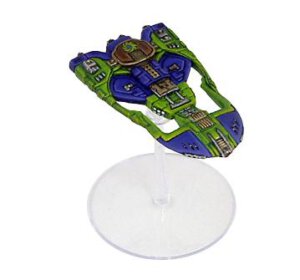
Publisher: Mongoose Publishing
Designer: Matthew Sprange
Year: 2011
Players: Two players
Ages: 12+
Playing Time: 30 minutes or more
Pages: 117 hardcover
Genre: Light science fiction fleet action miniatures game
Retail Price: $29.99
Never having played any previous incarnation of this rule system let me step into the shoes of a fleet commander without any preconceived notions of what I was hoping this game would or would not be. Understanding that the system was originally released as a Babylon 5 miniatures game a few years back, this new edition has been reworked into the Fading Suns RPG setting. As I’m not intimately familiar with that setting either, I can say that I was about as open minded about these rules as anything else I’ve run across.
I’ll also point out that this is simply a review of the rules as I did not have any of the miniatures available. I simply utilized counters I had available and adjusted for scale. Overall, I don’t believe either having or not having the minis affects my overall take on the system.
The game pits any of five royal houses in fleet based starship combat. These fleets could be made up of just a handful of small ships on each side to battles consisting of large capital ships alongside their support units. Each ship carries a point value and the scenarios are set up with specific spend levels. You can enjoy a small scale fight that can be completed in thirty or forty minutes or an all-out war that lasts an entire evening.

Initiative – Simply this determines the tactical advantage for the turn by rolling 2D6 and modifying the result by any race bonus. The high roll wins initiative. This phase is also where ships floating adrift are moved, or any other action that doesn’t require a player’s interaction.
Movement – The player with the initiative can choose to move a ship or have his opponent move one of theirs. Players then alternate the moving of ships and if one fleet is larger than the other the extra ships move last. I found the movement rules to be a bit too overly simple for my taste.
Attack – Just as in movement, players will alternate fire. Obviously, if you have the initiative you’ll attack with one of your ships first. You’re never required to make an attack though.
Boarding – In this phase players attempt to grapple and board enemy ships in the hopes of capturing them. It’s important to note that destroying a ship gives you half their victory points while capturing a vessel nets you the full value.
End Phase – This is the clean up phase with Damage Control and book-keeping taking place.
A Call to Arms: Noble Armada plays rather quickly and I would term it as a fairly simple system to learn. Of the 117 pages, the basic game is covered in the first twenty one. The rest of the book details advanced rules, fleet information, setting background, and scenarios. None of the rules or concepts are difficult to grasp and I think that more complex mechanics could have been implemented but weren’t simply to keep the game flowing rather quickly.
Of interest are the mechanics regarding critical hits as well as boarding actions.
Critical hits are handled in an escalating manner as opposed to completely random generation. In other words, the first critical hit to the engines will more than likely simply slow the targeted vessel down. Certain weapons that are exceptionally devastating can cause more reduction steps but you aren’t going to completely knock a ship’s engines out with a lucky shot. Critical hits take place fairly often as a six on a D6 brings about a roll on the Crit table.
Boarding actions are fairly common as well seeing that you score the full victory point value for captured ships and only half for destroyed ships. Boarding is resolved by just a few die rolls and can be quick and deadly.
Many of the mechanics involved in A Call to Arms: Noble Armada only require a single die roll or two for resolution and there in lays one of the issues I have with the game. Even adding in the special traits or abilities for various classes and crews, many of the concepts for CtA seem a bit dumbed down or tacked on. Movements of various vessels are extremely simplified and take up only a single page of the rulebook. Also, since the system uses only six sided dice, some of the percentages seem a bit skewed; I think the use of ten sided dice would have led to a greater range of results.

Another item of note is that the different fleets don’t seem especially balanced. Even though the vessels have various point costs, some seem to be over or under powered when compared to those of other factions carrying the same value.
In the end, A Call to Arms: Noble Armada is a fun, quick playing starship combat game that should even appeal to people unfamiliar with the Fading Sun milieu. For those who want to fit in a few battles in a single evening, there’s enough here to keep them happy. On the other hand, if you’re looking for a more detailed and tactically demanding system to simulate space fleet actions you might just want to look elsewhere. CtA doesn’t reinvent the wheel in any respect but all in all worth a purchase if you’re new to the realm of starship minis.
- Pinebox, TX Middle School Boxed Set Reviewed - Dec 24, 2024
- Score Big Savings with the Fifty-Dungeon Bundle of Holding - Dec 24, 2024
- The ACKS II Revised Rulebook Lands in PDF - Dec 24, 2024


















